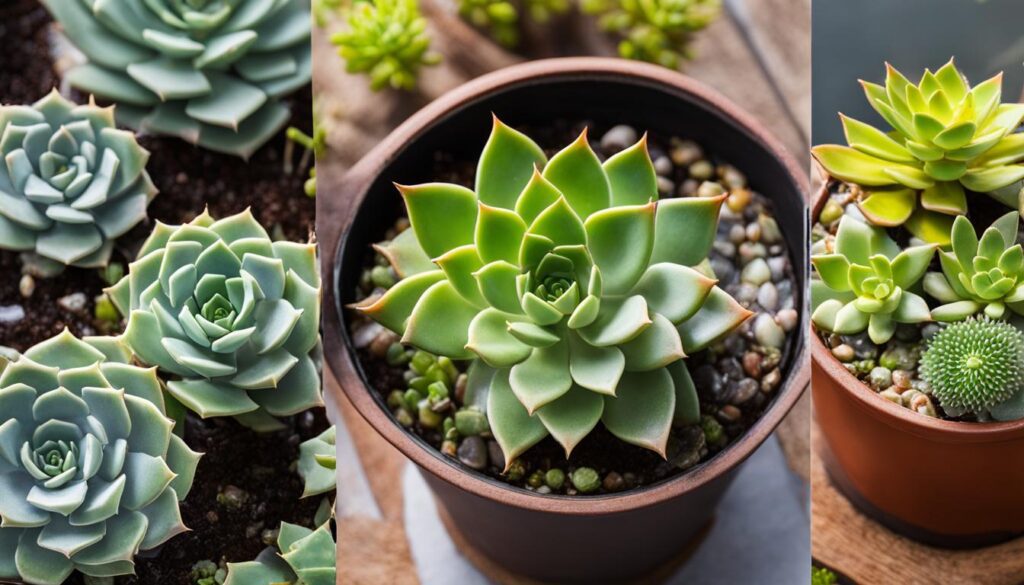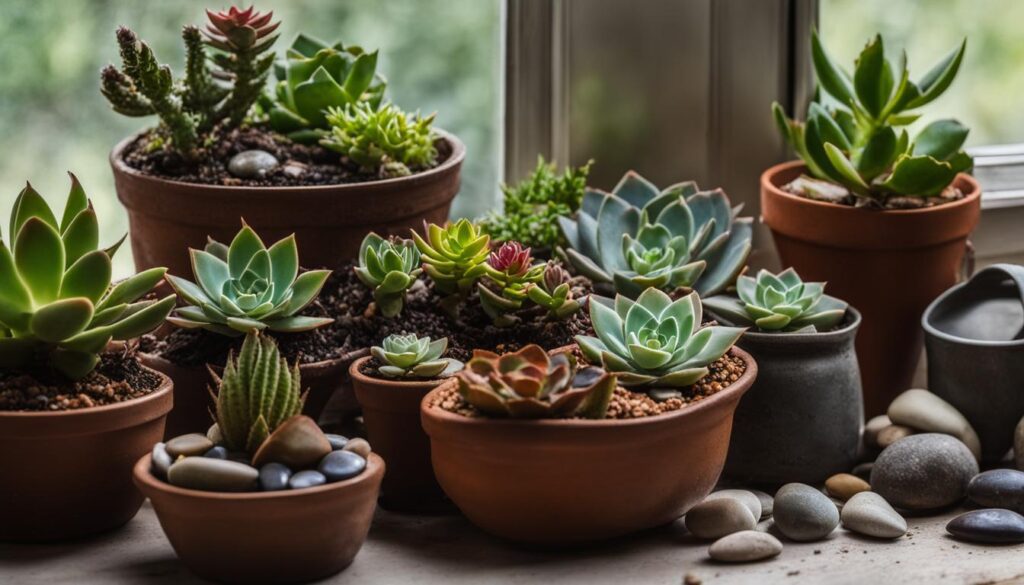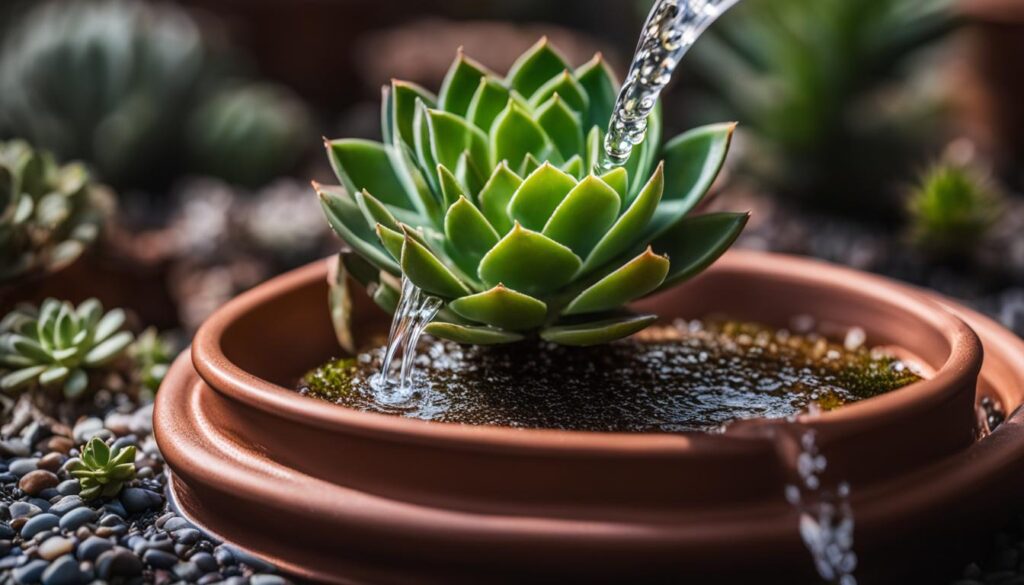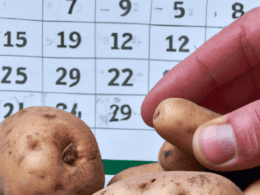Watering succulents without drainage can be a challenge, but with the right techniques, you can keep your succulents thriving. In pots without drainage holes, it’s important to choose the right soil, water carefully, and pay attention to signs of overwatering. By following these tips, you can ensure that your succulents stay healthy and happy.
Post Summary
- Choosing the right soil is essential for succulents without drainage.
- Be mindful of the amount of water you pour to prevent overwatering.
- Observing your succulents’ needs and adjusting watering accordingly is important.
- Ensure the soil is completely dry before watering again.
- Avoid common mistakes such as overwatering and soil saturation.
Why Drainage is Important for Succulents
Succulents have a unique root system that requires quick drying to prevent rot. When succulents sit in water for too long, they can develop root rot and other issues. This is why pots with drainage holes are recommended for beginners. However, if you prefer to keep your succulents indoors or in non-draining pots, it’s important to water them properly to avoid overwatering and root rot.
Proper drainage is essential for succulents because their roots are adapted to survive in arid conditions. These plants store water in their leaves and stems, and their roots are designed to take in water quickly and efficiently when it’s available. However, if the soil becomes waterlogged and doesn’t allow for proper drainage, the roots can become waterlogged and start to rot.
When succulents are watered too frequently or if their pots lack drainage, the excess water cannot escape, leading to high soil moisture levels. This can create an environment that promotes the growth of harmful bacteria or fungi, and ultimately causes root rot. Root rot can be difficult to detect until it’s well advanced, as the symptoms may not be visible above the soil surface. By the time signs of the disease appear, it may be too late to save the plant.
To prevent root rot and other watering problems, it’s important to choose pots with drainage holes whenever possible. These allow excess water to escape, reducing the risk of waterlogging and root rot. If you do choose to use pots without drainage, make sure to water your succulents sparingly and allow the soil to dry out completely between watering sessions. This will help prevent the soil from becoming waterlogged and ensure the health and longevity of your succulents.
Choosing the Right Pot for Succulents Without Drainage
When it comes to choosing pots for your succulents without drainage, there are a few options to consider. One of the best options is terracotta pots. These pots are made of porous clay, allowing for better airflow and faster drying of the soil. The porous nature of terracotta pots helps prevent water from sitting at the bottom and causing root rot. Plus, they have a natural and rustic look that complements the beauty of succulents.
Another option to consider is glass containers. Glass containers can create a stunning visual display for your succulents and allow you to see the roots growing. However, it’s important to be cautious when using glass containers, as they can intensify the heat, especially if placed in direct sunlight. This can increase the risk of overwatering and damage to the succulents. If you choose to use glass containers, make sure to monitor the moisture levels closely and adjust your watering accordingly.
Open terrariums are also an option for growing succulents without drainage. These enclosed containers offer a controlled environment for your succulents, helping to create a mini-ecosystem. However, it’s crucial to choose open terrariums that allow for proper air circulation to prevent moisture buildup and root rot. Additionally, be mindful of the choice of plants you place in an open terrarium, as succulents have different water and light requirements compared to other plants.
| Pot Type | Advantages | Disadvantages |
|---|---|---|
| Terracotta pots | – Allows for better airflow and faster drying of soil – Natural and rustic look |
– Can break if mishandled – Requires regular monitoring and adjustment of watering |
| Glass containers | – Creates a stunning visual display – Allows root visibility |
– Intensifies heat and risk of overwatering – Requires close monitoring of moisture levels |
| Open terrariums | – Provides a controlled environment – Creates a mini-ecosystem |
– Requires proper air circulation to prevent moisture buildup – Careful selection of plants with similar needs |
Remember, whichever pot you choose for your succulents without drainage, the key is to be mindful of the watering and moisture levels. You want to avoid overwatering and root rot, so adjust your watering frequency based on the specific needs of your succulents and the dryness of the soil. With the right pot and proper care, your succulents can thrive even without drainage holes.
Preparing the Potting Medium for Succulents Without Drainage
When growing succulents in pots without drainage holes, it’s essential to create a well-draining potting medium. Choosing the right materials and ensuring proper drainage can help prevent water accumulation and promote the overall health of your succulents.
Using Well-Draining Soil
The key to preparing the potting medium for succulents without drainage is to use well-draining soil. This type of soil allows excess water to flow through and prevents the roots from sitting in water, which can lead to root rot. Well-draining succulent soil is typically a mixture of regular potting soil and various inorganic materials like sand, perlite, or pumice.
Adding Rocks, Pebbles, or Stones
In addition to using well-draining soil, you can enhance drainage by adding a layer of rocks, pebbles, or stones at the bottom of the pot. This layer creates space for excess water to collect without saturating the soil. It also helps to prevent the soil from directly touching the bottom of the pot, allowing for better airflow and faster drying.
Consider Using Pumice
Pumice is a lightweight volcanic rock that is highly porous and helps improve soil aeration and drainage. It can be added to the potting medium or used as a top dressing. Pumice retains some moisture but prevents water from pooling around the roots, making it an excellent addition to the potting mix for succulents grown without drainage.
Table: Materials for Preparing the Potting Medium
| Material | Description |
|---|---|
| Succulent soil | A well-draining soil mixture specifically formulated for succulents. |
| Rocks, pebbles, or stones | A layer at the bottom of the pot to enhance drainage. |
| Pumice | A lightweight volcanic rock that improves soil aeration and drainage. |
Summary
When preparing the potting medium for succulents without drainage, it’s crucial to use well-draining soil that allows excess water to flow through. Adding a layer of rocks, pebbles, or stones at the bottom of the pot can further enhance drainage. Consider incorporating pumice into the potting mix for improved soil aeration and moisture regulation. By creating a well-draining potting medium, you can provide the optimal growing conditions for your succulents and prevent issues like root rot.
Watering Techniques for Succulents Without Drainage
When it comes to watering succulents without drainage, there are a few key techniques to keep in mind. Proper watering is crucial for maintaining the health of your succulents and preventing issues such as overwatering and root rot. Here are some effective watering techniques to help you keep your succulents thriving:
1. Measuring Water
One of the best ways to prevent overwatering is to measure the amount of water you pour into your succulent pots. Using a measuring cup or a squeeze bottle can help you accurately assess the quantity of water you’re adding. This ensures that you’re providing just the right amount of water without saturating the soil.
2. Using a Moisture Meter
A moisture meter is a handy tool that allows you to measure the moisture content of the soil. By inserting the probe into the soil, you can determine whether it is dry, moist, or wet. This helps you gauge the watering needs of your succulents and avoid watering them when the soil is still damp.
3. Monitoring Soil Dryness
An effective way to determine when to water your succulents is to observe the dryness of the soil. You can simply use your finger to touch the soil surface and check if it’s completely dry. If the soil feels damp or moist, it’s a sign that your succulents don’t need watering yet. Waiting for the soil to dry out completely between waterings helps prevent overwatering and promotes healthy root growth.
By incorporating these watering techniques into your succulent care routine, you can ensure that your plants receive the right amount of water without the need for drainage holes. Remember to adjust your watering frequency based on your specific succulent’s needs and the dryness of the soil. With proper watering, your succulents will thrive in their non-draining pots and remain healthy and beautiful.
Tips for Growing Succulents Without Drainage
When growing succulents without drainage, there are a few key tips to keep in mind to ensure the health and longevity of your plants. First and foremost, using a well-draining soil is essential. Succulents need soil that allows water to flow through easily, preventing water retention and the risk of root rot. Look for a high-quality succulent soil mix that contains materials like perlite, sand, and organic matter.
In addition to using the right soil, it’s important to measure your watering carefully. Pouring too much water into pots without drainage can lead to overwatering and soggy soil. Use a kitchen measuring cup or other measuring tools to add the appropriate amount of water to your plants. As a general guideline, pour water equal to half the volume of the planter. However, it’s important to observe your succulents’ needs and adjust the watering amount accordingly.
Observing your succulents is crucial when growing them without drainage. Each plant has unique water requirements, and it’s essential to pay attention to their appearance and soil dryness. Check the soil with your finger or use a moisture meter to determine when it’s time to water. Succulents typically prefer to be watered when the soil is completely dry, so always aim for dry soil before watering.
Lastly, it’s important to let the soil dry out completely before watering again. Succulents are adapted to withstand periods of drought, and they prefer to be under-watered rather than over-watered. Allowing the soil to dry out fully helps prevent the risk of overwatering and promotes healthy root growth. Remember to adjust your watering frequency based on the specific needs of your succulents and the dryness of the soil.
| Tips for Growing Succulents Without Drainage |
|---|
| Use well-draining soil mix |
| Measure water carefully to avoid overwatering |
| Observe your succulents’ appearance and soil dryness |
| Let the soil dry out completely between waterings |
The Importance of Succulent Soil in Drainage
When it comes to growing succulents without drainage, the choice of soil is of paramount importance. Well-draining succulent soil plays a crucial role in preventing water retention and promoting healthy root growth. It helps create an environment where excess water can quickly drain away, reducing the risk of overwatering and root rot.
Well-draining succulent soil is typically a blend of different materials, such as perlite, sand, and organic matter. Perlite is a lightweight volcanic rock that helps improve aeration and drainage in the soil. Sand also aids in soil drainage by increasing the space between particles. Additionally, organic matter, such as compost or peat moss, provides essential nutrients for the succulents’ growth.
Using a high-quality succulent soil mix, like Ramsey Succulent Soil, ensures that your succulents have the best chance of thriving. This specialized soil mix is specifically formulated to meet the unique needs of succulents, providing the ideal balance of moisture retention and drainage. Incorporating succulent soil into your planting process is a crucial step towards cultivating healthy and vibrant succulents without drainage.
Using a kitchen measuring cup allows you to pour water directly onto the soil, avoiding the leaves and preventing any potential damage. It also helps you keep track of the amount of water you’ve used, making it easier to ensure consistency in your watering routine.
Watering Instructions for Succulents Without Drainage
Here’s a step-by-step guide on watering succulents without drainage:
- Fill a kitchen measuring cup or other measuring tool with water.
- Pour the water slowly and directly onto the soil, avoiding the leaves.
- Observe the soil’s absorption capacity and stop watering when you reach the desired moisture level.
- Wait until the soil is completely dry before watering again.
Remember, the key is to ensure that the soil is dry before you water your succulents again. This helps prevent the risk of overwatering and allows the roots to receive the right amount of moisture they need to thrive.
Watering Frequency for Succulents Without Drainage
Watering frequency is a crucial factor to consider when caring for succulents without drainage. These plants have unique water requirements, and overwatering can lead to root rot and other issues. It is important to understand the signs of dry soil and adjust your watering schedule accordingly. By following these guidelines, you can ensure the health and longevity of your succulents.
One of the key indicators that your succulents need watering is the dryness of the soil. Before watering, gently insert your finger into the soil up to the second knuckle. If the soil feels completely dry, it is time to water your succulents. However, if the soil still feels slightly moist, it is best to wait and check again in a few days. Remember, succulents are adapted to arid conditions and can tolerate periods of drought.
As a general rule, succulents without drainage typically require watering once or twice a week. However, it is important to assess the specific needs of your succulents and adjust the frequency accordingly. Factors such as the type of succulent, the pot size, and the environmental conditions can all influence the watering requirements. Keep a close eye on your plants and observe how they respond to your watering routine.
Determining Watering Frequency
Determining the ideal watering frequency for your succulents requires a combination of observation and experimentation. Here are a few steps to help you find the right balance:
- Start with a conservative watering approach. Begin by watering your succulents once a week and observe how they react. Look for signs of overwatering, such as yellowing leaves or soft, mushy stems.
- Adjust the watering frequency based on the dryness of the soil. If the soil remains consistently damp or you notice signs of overwatering, reduce the watering frequency. Conversely, if the soil dries out too quickly and your succulents appear dehydrated, increase the watering frequency.
- Take into account seasonal variations. Succulents may require more frequent watering during the warmer months when they are actively growing. In contrast, they may enter a period of dormancy during the colder months and require less water.
Remember, it is always better to err on the side of underwatering rather than overwatering when it comes to succulents. These resilient plants are adapted to survive in arid conditions and can tolerate periods of drought. By carefully monitoring the dryness of the soil and adjusting your watering frequency accordingly, you can ensure the health and vitality of your succulents.
| Signs of Overwatering | Signs of Underwatering |
|---|---|
| – Yellowing leaves | – Wrinkled or shriveled leaves |
| – Soft, mushy stems | – Dry, brittle leaves |
| – Root rot or fungal growth | – Slow or stunted growth |
Common Mistakes to Avoid When Growing Succulents Without Drainage
Growing succulents without drainage can be a rewarding experience, but it’s important to avoid common mistakes that can harm your plants. Understanding these mistakes and taking steps to prevent them will help you maintain healthy succulents that thrive in pots without drainage holes.
1. Overwatering
One of the biggest mistakes succulent owners make is overwatering. Succulents are adapted to survive in arid environments and store water in their leaves and stems. They do not require frequent watering like other houseplants. Overwatering can lead to root rot, where the roots become waterlogged and susceptible to disease. To avoid this mistake, water your succulents only when the soil is completely dry and use a moisture meter or test the soil’s dryness with your finger.
2. Ignoring Signs of Root Rot
Root rot is a serious condition that can occur when succulents are overwatered or when the soil does not have adequate drainage. It is important to keep an eye out for signs of root rot, such as yellowing leaves, soft and mushy stems, and a foul smell coming from the soil. If you notice these signs, it is crucial to take immediate action by removing the affected plant from its pot, cutting away any rotting roots, and repotting it in fresh, well-draining soil.
3. Allowing Soil Saturation
In pots without drainage holes, it’s important to ensure that the soil does not become saturated with water. Without proper drainage, excess water can accumulate at the bottom of the pot, leading to soil saturation and potential root rot. To prevent this, use a well-draining succulent soil mix and incorporate materials like perlite or pumice to improve drainage. Additionally, water your succulents sparingly and avoid pouring excess water that can pool at the bottom of the pot.
Avoiding these common mistakes will help you successfully grow succulents in pots without drainage holes. Remember to water your succulents sparingly, pay attention to signs of root rot, and ensure that the soil does not become saturated. With proper care, your succulents will thrive and bring beauty and joy to your space.
Conclusion
In conclusion, watering succulents without drainage can be successfully achieved by implementing the right techniques and utilizing appropriate materials. By selecting well-draining soil and carefully measuring the water, you can ensure the health and prosperity of your succulents. It is crucial to observe your plants’ needs and adjust your watering frequency accordingly, based on the dryness of the soil.
Remember, overwatering is the most common mistake to avoid when growing succulents without drainage. It can lead to detrimental root rot and soil saturation. By paying attention to your succulents’ appearance and the dryness of the soil, you can prevent these issues and provide optimal care. With proper attention and care, your succulents can thrive even in pots without drainage holes.
In summary, by following the techniques discussed in this article, watering succulents without drainage can be accomplished successfully. Use well-draining soil, measure water carefully, and adjust your watering frequency based on your plants’ needs and the moisture level of the soil. By prioritizing the well-being of your succulents, you can ensure their health and longevity, even in pots without drainage.
Should I Water My Succulents Without Drainage Similar to the Peace Lily?
When it comes to identifying peace lily watering issues, it’s important to consider the drainage of the pots for succulents. Watering succulents without drainage, similar to the peace lily, can lead to overwatering and root rot. It’s best to use pots with drainage holes to prevent water from accumulating.
FAQ
What is the importance of drainage for succulents?
Drainage is important for succulents to prevent root rot and other issues caused by water saturation.
What kind of pots are suitable for succulents without drainage?
Terracotta pots are the best option, but glass containers or open terrariums can also be used with caution.
How can I promote drainage in pots without holes?
Use well-draining soil and add materials like rocks or pebbles to the bottom of the pot to create space for water to evaporate.
How should I measure the water when watering succulents without drainage?
Use a measuring cup or other measuring tools to add the right amount of water and prevent overwatering.
How often should I water succulents without drainage?
Water succulents when the soil is completely dry, typically once or twice a week, but adjust based on your specific succulent’s needs.
What are common mistakes to avoid when growing succulents without drainage?
Overwatering and not allowing the soil to dry adequately are common mistakes that can lead to root rot and soil saturation.
Why is succulent soil important in promoting drainage?
Well-draining succulent soil prevents water retention and provides essential nutrients for healthy succulent growth.
How can I measure water accurately for watering succulents without drainage?
Use a kitchen measuring cup or other measuring tools to add the right amount of water without overwatering.
How frequently should I water succulents without drainage?
Water succulents when the soil is completely dry, but adjust based on the dryness of the soil and your succulent’s needs.
What are common mistakes to avoid when growing succulents without drainage?
Avoid overwatering and ensure the soil is completely dry before watering again to prevent root rot and soil saturation.











